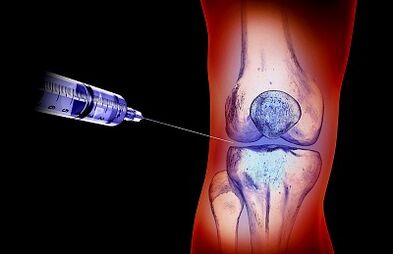
The knee, as well as other compounds of a person, consists of bones and cartilage.The cartoon is a smooth, elastic and elastic layer that guarantees the ease of walking and lack of friction.It is called crunchy damage by chronic wearArthrosis of knee wrist.
There are many factors that lead to joint college arthrosis:
- Genetic predisposition;
- excess weight;
- abnormal motion;
- Injuries.
Long, the person does not experience pain only when the knee arthrosis leads to the estimated deformation, the first symptoms appear.The patient is advised with a doctor, but the treatment of advanced disease can already be successful.
The arthrosis of the knee joint is often a result of accidents and injuries, but it can only manifest it after a few years.Therefore, with the lowest suspicion of this disease, you should consult a doctor.
Symptoms Arthrosis knee joint
The symptoms of the knee joint arthrosis include:

- pain that increases during activity;
- swelling;
- Increasing the skin temperature;
- Reduction of knee joint mobility;
- Cracking, crispy sound that is heard during the movement.
The pain after the inactivity period is one of the most common symptoms of the knee arthrosis.It is expressed in the morning, when the joints takes time to warm up the right way.Once a person is like some time, the pain is overcome.
Sometimes you can notice the first signs of the arthrosis of your knees just looking at it.Even if the knees break out more than usual, this may be the first sign.Increased knee tendency to swelling is easy to recognize.Lost in the thickness of your finger is formed above the kupa knees, because this place is the weakest.This is due to the increase in the accumulation of liquid in the compound.
Reducing flexibility in legs may indicate the arthrosis of the knee joint.Those who used to touch the heel buttocks, standing on one leg, but I can go halfway today, they need to consult a doctor.Mice muscles can begin to work harder than before, due to the arthrosis of the knee, becoming shorter and start hurting.These muscles should stretch and strengthen to restore previous features.
Another sign of the wrist of the knee wrist is a reduction in the strength of the muscles in the legs.
Arthrosis becomes cartilage, which is smooth as glass in a rough cloth that looks like sandpaper in early stages.When these surfaces rub on each other, you can hear creaking and friction sounds in the compound.
How is the knee arthrosis diagnosed?

The diagnosis of osteoarthritis of the knee will begin with a doctor's examination of the doctor.Before taking, determine which pain arises to help the doctor make the correct diagnosis.In addition, find out if someone has arthritis in your family.
Your doctor can prescribe an additional diagnosis, including:
- Recording magnetic resonance (MRI) scan X-rays that can show bones and damage to cartilage, as well as the presence of bones;
- The MRI can be ordered when X-rays do not give a clear cause of pain in the joints or when X-rays show that other types of shared tissue can be damaged.Doctors can use blood tests to exclude other conditions that can cause pain, such as rheumatoid arthritis, another type of arthritis caused by a damaged immune system.
How is your knee arthrosis treated?
The main tasks of treatment of osteoarthritis of the knee joint are relieving pain and refund of mobility.
Plan for treatment, as a rule, includes a combination of the following actions:
- Weight loss.Loss of even small amounts of weight, if necessary, can significantly reduce the pain in the knee from osteoarthritis.
- Exercise.Strengthening the muscles around the knees make the state of compounds more stable and reduces pain.Stretching exercises help maintain mobile and flexible knees.
- Anesthetic and anti -infalmator medications:Acetaminophen, ibuprofen or sodium.If medications do not make relief, your doctor can give you a prescription of another anti -infallamator drug to soften the pain.
- Injections of corticosteroids or hyaluronic acids in the knee.Steroids are powerful anti-inflammatory medications.Hyaluronic acid is usually present in the joints as a type of lubricant, but with the diseases of the joints, he is missing him.
- Alternative ways of treatment.Some alternative methods of treatment that can be effective include: Capsaicine creams, acupuncture, or additives, including glucosamine and hondroitin.
- Use of devices such as brackets.There are two types of parentheses: those unloading braces, thus removing weight on the side of the knee;and "support" brackets that provide support to the entire knee.
- Physical activity and work therapy. If you have problems with everyday activities, physical exercise or work therapy can help.Physiotherapists will teach you how to strengthen muscles and increase the flexibility in the wrist.Specialists will compile a set of exercises suitable for you to perform at home to reduce pain.
- Operation.When other treatment methods do not work, the operation is the only option to release the disease.

Is the operation used to treat osteoarthritis of your knees?
For the treatment of osteoarthritis of the knee with the help of surgical intervention, the following options are possible: Arthroscopy, osteotomy, endoprosthetics.
InarthroscopyA small telescope (Arthroskope) and other small tools are used.The operation is done through small cuts.The surgeon uses an arthroscope so that the wrist can be seen.Once the surgeon can remove the cartilage or damaged free particles, it can clean the surface of the bones.The procedure is often used on patients aged 55 (and younger) to delay more serious work.
Osteotomy- This is a procedure that seeks to align the knee, changing the form of bones.This type of work can be recommended if you have any damage, above all, in one knee area.It can also be recommended if you have damaged your knee and not renewed.Osteotomy has no permanent effect and operation may be needed in the future.
Endoprosthetics- This is a surgical procedure in which the joints were replaced by artificial parts of metal or plastic.Replacement may include one side or whole knee.As a rule, people older than 50 years and the heavy form of osteoarthritis need a replacement.The operation may be sought later, if the replacement is betrayed after a few years, but with modern achievements, most prostheses have served more than 20 years.The operation has risks, but the results are usually very good.



















